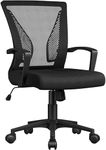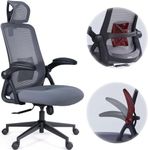Buying Guide for the Best Budget Office Chairs
Choosing the right office chair is crucial for maintaining comfort and productivity during long hours of work. A good office chair should support your posture, be adjustable to fit your body, and be durable enough to withstand daily use. When selecting an office chair, consider how much time you spend sitting, your body type, and any specific ergonomic needs you may have. It's important to try out different chairs if possible, to see which one feels the most comfortable and supportive for you.ErgonomicsErgonomics refers to how well a chair supports your body, particularly your back, neck, and arms, to prevent strain and injury. A chair with good ergonomics will have features like lumbar support, adjustable armrests, and a seat that can be adjusted for height and tilt. When choosing an ergonomic chair, consider how much support you need based on your typical sitting posture and any existing discomfort you experience. If you spend long hours at your desk, prioritize chairs with comprehensive ergonomic features.
AdjustabilityAdjustability is the range of modifications you can make to a chair to fit your body and preferences. This includes seat height, backrest angle, armrest height, and lumbar support. A highly adjustable chair allows you to customize it to your specific needs, which is important for maintaining comfort and reducing the risk of strain. If you share your chair with others or have specific comfort needs, look for a chair with multiple adjustable features.
MaterialThe material of an office chair affects its comfort, durability, and breathability. Common materials include mesh, fabric, and leather. Mesh chairs are breathable and keep you cool, fabric chairs offer a variety of colors and textures, and leather chairs provide a classic look and are easy to clean. Consider the climate of your workspace and your personal comfort preferences when choosing a material. If you tend to get warm easily, a mesh chair might be best, while a fabric or leather chair might be more suitable for cooler environments.
Seat Depth and WidthSeat depth and width determine how well a chair can accommodate your body size. A seat that is too small can be uncomfortable, while one that is too large may not provide adequate support. Ideally, you should be able to sit with your back against the backrest and have a few inches of space between the back of your knees and the seat edge. Consider your body size and how much space you need to sit comfortably when evaluating seat dimensions.
Weight CapacityWeight capacity is the maximum weight a chair can safely support. It's important to choose a chair that can accommodate your weight to ensure safety and durability. Chairs typically have a weight capacity ranging from 250 to 400 pounds. If you are close to or exceed the standard weight capacity, look for chairs designed to support higher weights to ensure stability and longevity.
MobilityMobility refers to how easily a chair can move around your workspace. Chairs with wheels or casters allow you to move freely without getting up, which can be convenient for multitasking. Consider the type of flooring in your workspace; hard floors may require different casters than carpeted floors. If you need to move around frequently, a chair with smooth-rolling casters is ideal.















